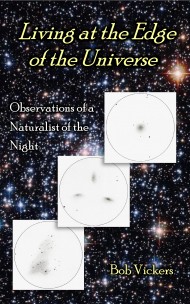Melissa and I decided to rent a cabin at Pennyrile State Park in Kentucky (home of the Twin Lakes Star Party) for a couple of days last week just to get away from the rat race. It was a wonderful experience, quiet and secluded, with very few other visitors at the time we were there.
We were pretty much surrounded by trees but could see the lake from the back deck. There was a pair of Canada Geese on the lake that we watched (and listened to all night!)
There was also a pair of flycatchers that I initially thought were Eastern Phoebes because of the tail bobing and their alternating high and low second note song. The wing bars seemed indistinct also. But after reviewing the picture below I’m not so sure. The wingbars seem more distinct here and there is no eyering which is more like the Eastern Pewee. Maybe there were both.
As we sat on the deck one of the flycatchers kept flying toward us and hovering just under the eave of the roof before retreating back to the railing. Finally it got brave enough to alight on one of the light fixtures just over my head. I immediately heard a chorus of faint but insistent chirping and discovered that there was a nest built on top of the light fixture and that it was occupied by several baby flycatchers. Melissa and I moved our chairs to the other end of the deck to clear the way for mama.
There were lots of birds including everything from Indigo Buntings and Scarlet Tanagers hiding in the brush to Turkey Vultures soaring overhead.
One day we drove up Pennyrile Parkway to Henderson, Kentucky, to visit Audubon State Park. We were driving along through a very rural part of the state when we suddenly entered Henderson and found ourselves traveling through a district with one of the highest concentrations of billboards, fast food restaurants, gas stations, and other businesses I have ever seen. When we finally saw the park entrance and turned off the strip it was like we had, as Melissa put it, “passed through the wardrobe into Narnia.” We were immediately surrounded by a thick forest of large trees with nary a billboard to be seen.
The main building is a combination nature center and museum of Audubon’s work and memorabilia. The museum was really impressive. Originally built in the 1930’s, it houses one of the best Audubon collections in the world. We took our time and meandered slowly through the displays. The nature center part of the building featured a glass wall where you could watch birds at feeders.
The museum is surrounded by a 724 acre old growth forest with a variety of hiking trails.

Me on one of the hiking trails at Audubon State Park, KY - Copyright (c) 2012 Robert D. Vickers, Jr.
The next day we drove back to Land Between the Lakes and the Golden Pond Planetarium to see a show called Two Small Pieces of Glass. I had seen previews of this show but had never seen it all the way through. It was delightful – definitely one of my favorites now. Ross Workman, the Planetarium Director, ran the theater show and also did a night sky show immediately afterward. Melissa and I enjoyed both very much.

Golden Pond Visitor Center & Planetarium - Land Between the Lakes, KY - Copyright (c) 2012 Robert D, Vickers, Jr.
After leaving the planetarium, we drove down to see the Kentucky Lake bridge. The missing section which was destroyed by a cargo ship mishap back in January is still missing but is supposed to be replaced soon. I took the picture below and we left to drive down the Trace and back home. It was a very relaxing getaway, just all too short. Total distance driven: 432.3 miles.
End of the day, back home again – Melissa and I sat outside and listened to Wood Thrushes as the Sun set. Their melodic song has a beautiful flute-like quality. We thought of John James Audubon and smiled.

